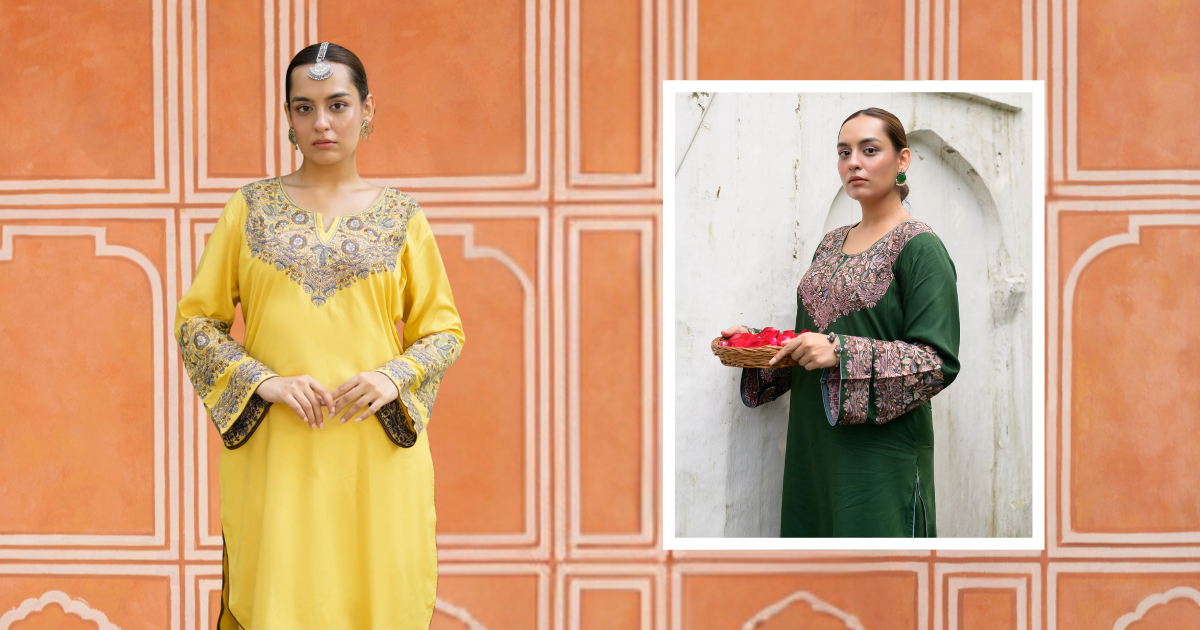India is home to a rich tapestry of textiles, each telling stories of its people, culture, and history. Among them, Kutch Embroidery from Gujarat stands out as one of the most intricate and culturally vibrant. With its bold colors, mirror embellishments, and elaborate patterns, this embroidery style is not just a decorative art. It's a legacy carried through generations of skilled artisans.
Source: Pinterest
The Origins of Kutch Embroidery
The roots of Kutch Embroidery can be traced back centuries to the arid region of Kutch in Gujarat. The nomadic Rabari community is believed to have introduced this art form as they traveled across Central Asia and settled in Kutch. Over time, different communities in the region, such as the Ahirs, Sodhas, and Meghwals, contributed their own distinct styles to the craft, enriching its diversity.
Each community developed its own motifs, stitches, and color schemes, creating a wide array of Kutch work styles. These designs were not just ornamental; they carried symbolic meanings related to protection, fertility, and prosperity. Traditionally, girls would begin learning embroidery from a young age, and by the time they were married, they would have created an entire trousseau of embroidered garments, home décor, and accessories.
The Signature of Kutch Work
Source: Pinterest
What sets Kutch work embroidery design apart is its rich detail and dynamic texture. The most recognizable feature is the use of mirror work embroidery, where small pieces of mirror, called "abhla," are stitched into the fabric using tight interlocking patterns. This technique not only enhances the visual appeal but also reflects light, making the fabric shimmer under the sun or soft lighting.
Geometric patterns, floral designs, and motifs inspired by nature and daily life are commonly seen in Kutch work designs. The embroidery often uses silk or cotton threads in vivid hues like red, yellow, green, and blue, contrasting beautifully against earthy or dark-colored fabrics. The stitching itself is complex, involving techniques like herringbone, satin, and chain stitches.
A Symbol of Cultural Identity
Source: Pinterest
For the people of Kutch embroidery is much more than an art form. It's an expression of identity and tradition. Even today, many women in the region use this skill as a means of livelihood, producing embroidered pieces that find their way into global fashion runways and boutique collections.
Over the years, Kutch Embroidery has gained international recognition. Designers and textile enthusiasts from around the world have celebrated its uniqueness, helping preserve its legacy while encouraging fair trade and sustainable practices. It has become a significant part of India’s cultural exports and is often showcased in exhibitions, museums, and cultural festivals globally.
Contemporary Revival and Sustainable Fashion
In recent times, there has been a conscious effort to preserve and modernize traditional crafts. Fashion brands and artisans have collaborated to bring Kutch work design into contemporary silhouettes, making it accessible and stylish for today’s generation. One of the most appreciated developments is its adaptation into everyday wear like shirts, kurtas, dresses, and even accessories like bags and stoles.
As part of this movement, Namastay is proud to announce the upcoming launch of its exclusive Kutch collection mirror work line. This collection highlights traditional artistry in modern, wearable styles made from breathable cotton that are perfect for summer and transitional weather.
Here’s a sneak peek into the collection:
-
Safa blue Kutch Mirror Work Embroidery Cotton Kurta – A striking blue kurta adorned with intricate mirror work, perfect for festive gatherings or cultural events.
-
Nuha Black Kutch Mirror Work Embroidery Cotton Short Kurta – A versatile black piece that blends traditional embroidery with a chic, short kurta design ideal for casual or semi-formal occasions.
-
Lina White Kutch Mirror Work Embroidery Cotton Short Kurta – Crisp, fresh white fabric paired with colorful mirror accents, making it a wardrobe essential with a vibrant twist.
-
Sania Yellow Kutch Mirror Work Embroidery Cotton Kurta – Bright and uplifting, this yellow kurta adds a splash of sunshine and heritage to your style.
This collection brings the essence of Kutch to your closet—handcrafted, ethical, and deeply rooted in culture. Each piece is made with attention to detail, supporting the artisans behind the craft and helping keep this timeless tradition alive.
In Conclusion
Kutch Embroidery is more than fabric and thread. It speaks of migration, identity, tradition, and survival. As fashion evolves, it’s inspiring to see age-old crafts find relevance in modern wardrobes, serving as a reminder that tradition and innovation can walk hand in hand.
So whether you're an admirer of ethnic fashion, a supporter of handcrafted products, or someone looking to add a piece of India’s textile legacy to your collection, Kutch work embroidery design offers a meaningful and stylish choice. Keep an eye out for Namastay’s Kutch mirror work collection. Your journey into Gujarat’s artisanal heritage is just a kurta away

















